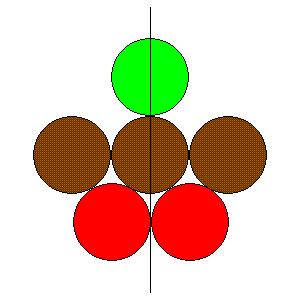-
Posts
871 -
Joined
-
Last visited
-
Days Won
7
Content Type
Profiles
Forums
Events
Gallery
Blogs
Everything posted by Prime
-
For starters, that estimate of probability is incorrect. Say, instead of 365, there were only two possible values -- "0" and "1". Let number of people be n=3 and the first one holds "1". Your formula for the probability of matching first man's number against the remaining two yields: P = 2/2 = 1 (or certainty). Note, how for more than 3 people the formula would produce probability value of greater than 1. Actually all combinations between two people are "00", "01", "10", "11". Four combinations in all. In three of those at least one other person holds the same number ("1") as the first person we set aside. For the resulting probability 3/4. A popular technique to calculate that kind of probability is to estimate the probability that none of the others has the same number (birthday). It makes it easier because you can view that probability as a series of dependent probabilities, which you can multiply. Thus for each of the n-1 individuals the probability not to share your b-day is 364/365. The probability that none of n-1 shares your b-day is (364/365)n-1. Then, since the probability of someone sharing you b-day or not is 1, the probability of at least one person of the remaining n-1 sharing your b-day is 1 - (364/365)n-1. The OP, however, asked to find when it is 50% of having at least any two people (not just you) in the room to have the same b-day. The simplest solution that someone already have posted here is to estimate the probability that no two people have the same b-day. So when there is one person in the room, the second walking in has a 364/365 chance not matching. The third person now must mismatch two b-days at the probability 363/365, the fourth person 362/365, and so on... The overall probability for n people is a product (364/365)*(363/365)* ...*(366-n)/365.
-
There are several ways to rotate an object 180O. 1). Rotating object could be oriented in space vertically (like a wheel). Then 180O rotation would make it upside down and swap left and right. Example: "nou" would make "nou". Rotating "b" would produce a mirror image of "p" (not a real "p"). "MOW" would end up the same "MOW" 2). Horizontal 180O rotation (like roulette) would produce a mirror image. Example: "MOW" would produce "WOM". If you rotate "bob" 180O twice -- one time vertically, and another time horizontally, it would end up as "pop".
-
I understand, a triplet is 3 consecutive coin tosses. And the triplets overlap. That is the same coin toss may be used in up to 3 consecutive triplets. That seems to create a dependency.
-
Here is one 180o rotational symmetry:
-
There is one small point to clarify. Namely, exactly what's the distance traveled by Prime-robot before going off the rail. For the corrolary problem with one closed end, I want to note that putting mirror at the closed end would represent a very specific case of the original problem. The case where the number of robots is always even, and they are arranged in a symmetrical pattern.
-
As I posted, any question, which is interpreted differently by the two persons. That is, the question must carry a variable within it, which is assigned/resolved based on person to whom the question is directed. Examples: Are you a truth-teller? Are you a liar? If both men are present in the room: Is the other guy liar? (or truth-teller) Does the other guy wear hat? (Provided one of them wears hat, and the other does not.) Is your shoelace untied? (Provided one of them has an untied shoelace.) The variable in each question is underlined. To put it simply, since both of them answer the truth, make them answer to a different thing while using the same question.
-
I made a typing error: for 15 independent triplets the number of variations is 245, of course. I am afraid, I don't see the point with predictability. Does it mean, if you make 17 tosses, then randomly picked triplet of tosses, say (1,9,17) are more likely to be heads? (Note there are 680 different triplets within a collection of 17 tosses.)
-
As usually with this type of problems, you ask a question, where the meaning is relative to person's identity.
-
Prove that infinite decimal fraction 0.999999... is exactly (not approximately) equal to 1. Short and simple proof is preferred.
-
There are 217 possible outcomes. They represent the number of orderings for any imbeded strings. Including the same instance of the coin toss into the different triplets makes them dependent. I.e., if we were to consider ordering of 15 completely independent triplets of coin tosses, the number of variations would be 218. One way or another, nothing is there to make random sequence predictable.
-
Have it your way. You've killed the Infinite Series in less than six shots.
-
This is where the reasoning breaks down for me: If P0 is probability of Player1 winning, then why would probability of Player2 be P0*5/6? 5/6 is the probability of a player missing his shot. We multiply dependent events. So that product is like saying: "First, Player1 must win, then Player1 must not win." Also, the probability P0 cannot be tied up to any specific round, but must represent the sum total of all rounds. Let me take a shot at explaining Bonanova’s solution the way I could understand it. Let's call the three turns of rolling dice (Bonanova, Prime, Octopuppy) a round. Before any given round the probability for Bonanova to win in that round is B=1/6; for Prime -- P=(5/6)*1/6; for Octopuppy -- (5/6)2*1/6. The total probability for the 3 men to win in any particular round "n" is probability that they get to that round "rn" times the sum of their probabilities for a single round: rn*(B+P+O) where (B+P+O)=(1/6 + 5/36 + 25/216)=91/216. The overall probability for someone winning in some round over an infinite number of rounds is: (B+P+O) + r2*(B+P+O) + r3*(B+P+O) + ... to infinity. Which we can rewrite as (B+P+O)*(1+r2+r3+r4+...). Let's designate the infinite sum (1+r2+r3+r4+...) with the letter "S". Knowing that the total probability of someone rolling 6 ever is 1, we have an equation: (B+P+O)*S = 1; or S*91/216 = 1. From which we find: S=216/91. Consequently: B = 1/6 * 216/91 = 36/91; P = 5/36 * 216/91 = 30/91; O = 25/216 * 216/91 = 25/91. So I don't see that Bonanova's solution managed to avoid infinite series. It just does not mention it. The only difference is that Bonanova finds the value for the infinite sum from an algebraic equation using the fact that overall probability must equal 1. Whereas, I found the value for geometric series using its well-known formula. Either way, it's the infinite sum.
-
I cannot top this flag passing model. And I don't see a need for any additional proof. The OP stated "before we can be certain", which means what's the longest possible time. And no flag can stay on the rails longer than one hour. And it is possible (and probable) for Prime to be the last robot off the rail.
-
Edit: I still don't get it. The probability of a win once you get a turn is exactly 1/6. Your formula yields 36/91. Infinite series seem so much simpler an explanation to me.
-
Same difference. Flip one switch on. Check resistance on the other two. Take a brick and walk upstairs. If the bulb is off, throw a brick at it. Walk downstairs and check the resistance on those two switches one more time. Nothing beats the moth solution, though.
-
This is my favorite game. It is called Russian Roulette and is played with a six-shooter -- not a die. I agree with CR’s reasoning and with Bonanova’s answer. (I did not quite understand Bonanova’s reasoning.)
-
In this scenario No.2 would have guessed his hat color.
-
Does "the two other remaining" mean the only two remaining beside Edward? Then how is tie possible?
-
I did a quick internet search and found, many attribute the "crocodile" version of the paradox to Ancient Greeks.
-
This looks like another variation on "undecidable proposition" paradoxes. Like classic Richard’s paradox, on which famous Godel's Incompleteness Theorem was based. A short version of undecidable proposition that I like: "THIS SENTENCE IS FALSE". Another classical variation Crocodile and baby had been posted already. I have seen that "crocodile" version being attributed in the literature to Lewis Carroll, the author of “Alice in Wonderland”.
-
I like it, how in the illustration above, the ferocious crocodile gradually turns into a frog, after being trapped in a logical impasse.
-
That seems like the only solution. However, the two mistaken truth-tellers need not be inserted into the same periodic group. I.e., it could be LTTT LTTT LTT LTT LTT... where each mistaken truth-teller is marked in red. That said, I have a problem with "mistaken truth-teller" concept. Ignorance is no excuse for making false statements. I do not accept them as truth-tellers. They must be an alltogether different tribe of Ignorant Knights. And then there must be a tribe of Ignorant Knaves. That may lead to a host of new and original problems.


